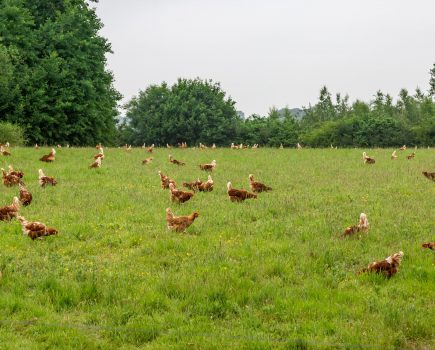Victoria Roberts focuses on nutirtional issues
Nutritional disorders in chickens may be caused by a dietary insufficiency, inhibition of absorption, a metabolic abnormality or starvation by being bullied away from the feed.
Fat-soluble vitamins (A & E) are involved with membranes, water-soluble vitamins with enzyme systems and minerals with bone growth and egg production. Commercial feeds contain all necessary nutrients so a simple deficiency is rare. If parent stock is well fed, then chicks and poults will hatch with a good source of nutrients in the yolk and have a good start in life.
Here is a checklist of key vitamins and minerals:
Vitamin A deficiency is unusual in outdoor birds with access to grass and on commercial feed, but many poultry are kept on too small an area, which rapidly becomes bare of all vegetation. They become prone to infections in the mouth and throat plus eye infections, are generally weak and stop laying. A supplement formulated for birds should help, and make sure they have access to grass. Because excess levels of Vitamin A are toxic, supplementation should be used with care.
Vitamin E functions as an antioxidant and deficiency can cause early embryo death, crazy chick disease (encephalomalacia), heart disease and nutritional muscular dystrophy, which usually occurs with blood leakage under the skin on the breast and under the wings. Commercial feed normally contains sufficient Vitamin E.
Vitamin K is involved in blood coagulation and may be affected if certain antibacterial drugs are used as these bind the vitamin.
B Vitamin deficiencies tend to manifest as skin disorders or poor hatchability, but the main B Vitamin that shows clinical signs at marginally low levels is B12 (riboflavin). Curly toe paralysis with the toes clenched (as opposed to toes bent sideways) plus clubbed down (first feathers) is a classic symptom in chicks, but again, unusual with commercial feed. Deficiency in adults results in embryo deaths in mid and late incubation (dead-in-shell). This vitamin is also needed for melanin production in black coloured birds.
Calcium and phosphorus ratio in feed should be 2:1. Calcium is vital throughout all body cells for efficient function, not just in bones, and phosphorus is important in protein synthesis and carbohydrate metabolism. Deficiency shows in depleted growth of the skeleton and rickets in young birds. It is said young birds are more prone to feather pecking with a calcium deficiency, but excess heat and stress are also implicated. Thin or soft shelled eggs is a sign in laying birds, but it is normal for the hen to metabolise calcium from her bones for shell formation if insufficient is provided in feed. Mash feed can result in a deficiency due to the heavier mineral particles settling out. Stress can make calcium unavailable temporarily. Calcium and phosphorus supplementation is best done in a naturally balanced form such as a seaweed supplement in order to maintain the optimum ratio, plus other minerals such as iodine. Excess calcium will lead to kidney failure, so do not feed a layer ration to growers until they are point of lay.
Vitamin D starts out as a steroid (cholesterol) and is converted by ultraviolet light to the vitamin. Birds sunbathe with wings and legs outstretched. Oil from the preen gland has a cholesterol component and thus contributes slightly to vitamin D production once on the feathers. It is essential for calcium transport in the blood. Outdoor birds with access to sunlight should not have a deficiency, neither should birds with limited outside access, such as on an aviary system and sharing a piece of grass every few days in rotation. Commercial feed is supplemented with vitamin D3 (the active version).
Sodium chloride Salt is added to all rations, but deficiency will depress egg production and increase cannibalism. Excess will cause convulsions and kidney damage.
Zinc is an essential trace element affecting growth, reproduction, skin and feathers. High calcium levels will reduce availability. In excess it is very toxic and damaged galvanised drinkers and feeders can produce toxicity resulting in weakness, weight loss and convulsions. Treatment is possible if done in the early stages of symptoms.
Fatty liver syndrome usually occurs with old, obese birds, which no longer take much exercise or lay eggs. The friable liver haemorrhages and birds will die, especially in hot weather. Check fat coverage by feeling the pin bones, either side of the vent – if they are very well covered, the bird may be obese and changes to the diet need to be made.







